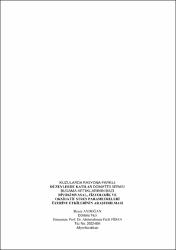Kuzularda rasyona farklı düzeylerde katılan domates serası budama artıklarının bazı biyokimyasal, fizyolojik ve oksidatif stres parametreleri üzerine etkilerinin araştırılması
Özet
Dünyada nüfusun hızla artmasına bağlı olarak beslenme sorunları ön plana çıkmaktadır. Özellikle ülkemiz bir tarım ülkesi olmasına rağmen, hayvan besleme yönünden sorunlar yaşamaktadır. Bundan dolayı da hayvan beslemede alternatif yemlere olan ihtiyaç artış göstermektedir. Bu sonuç doğrultusunda yoğun şekilde üretimi yapılan domates bitkisinden çok miktarda açığa çıkan domates yaprağının, atık ürün olmaktan çıkartılıp alternatif bir yem hammaddesi olarak geri dönüşümünün sağlanması, ülkemiz hayvancılığı için yem açığının kapatılması açısından oldukça önem taşımaktadır. Bu tez kapsamında Anadolu Merinos ırkı kuzuların rasyonlarına farklı düzeylerde fermente domates yaprağı (FDY) katılması sonucunda elde edilen bazı biyokimyasal, fizyolojik ve oksidatif stres parametreleri araştırılmıştır. Deneme düzeninde 65±5 günlük yaşta, 19,61±4,33 kg başlangıç canlı ağırlığında, 24 adet erkek kuzu kullanılmış olup, rastgele blok düzeni içerisinde padoklara yerleştirilerek, 3 gruba ayrılmıştır. Çalışma 8 haftada tamamlanmıştır. Gruplar; kontrol, %2,5 FDY, %5 FDY olarak ve her grupta 8’er hayvan olacak şekilde ayarlanmıştır. Kontrol grubuna deneme süreci boyunca FDY içermeyen temel rasyon verilirken, %2,5 FDY grubu ve %5 FDY grubu toplam karma rasyon (TMR)’da sırasıyla %2,5 ve %5 FDY içeren rasyonla beslenmiştir. Çalışma süresince her bir hayvanın bireysel günlük yem tüketimi belirlenmiş, her hafta canlı ağırlık tartımları ve vücut ölçümleri kaydedilmiştir. Deneme süresi boyunca her 14 günde bir toplamda 5 kez olmak üzere, kan örneği alınmıştır. Ayrıca çalışmanın son 3 günü günde bir kez olacak şekilde rektal yolla her bir hayvandan dışkı örneklemesi alınmıştır. Çalışmanın sonunda ise, kesim işlemi gerçekleşen kuzuların, karaciğer ve böbrek ağırlıkları tartılıp, bağırsağa ait numuneler alınarak analizleri yapılmıştır. Kesim sırasında rumenden içerik alındığı anda pH değeri ölçülmüş ve uçucu yağ asidi (VFA) profili analizleri gerçekleştirilmiştir. Analiz sonuçlarının istatistik değerlendirmesi SAS programında yapılmıştır. Elde edilen veriler incelendiğinde; performans ve büyümeye bağlı parametreler ile dışkı çıkışı ve organ ağırlıkları parametreleri üzerinde değişiklik yapmadığı gözlenmiştir (p>0,05). Ancak, hematoloji ve serum biyokimyası ölçümlerinde; üre azotu (BUN) ve granülosit yüzdesi (GRA%) değerlerini, serum lipit profilinden; esterleştirilmemiş yağ asitleri (NEFA) ve fosfolipit değerlerini, rumen parametrelerinden; pH değeri ve ince bağırsak parametrelerinden; absorbans yüzeyi değerini etkilediği belirlenmiştir (p≤0,05). Sonuç olarak yaptığımız bu çalışmada; atık ürün olarak nitelendirilerek hem çevreye hem de ekonomiye zarar veren budama artıklarının, uygulanan oranlarda rasyona eklenmesi ile ruminantlarda yonca peletine eşdeğer bir kıymette alternatif yem hammaddesi olarak kullanılabileceği, böylece hem hayvancılık girdilerini düşüreceği hem de bu artık maddelerin daha yüksek katma değerle tüketilmesinin sağlanabileceği kanaatine varılmıştır. Due to the rapid increase in the population in the world, nutritional problems became more important than ever. Although our country is an agricultural country, it has problems in terms of animal feeding. Therefore, the need for alternative feeds in animal nutrition is increasing. In line with this result, it is very important for our country to close the feed deficit for animal husbandry to ensure that the tomato leaves, which are released in large quantities from the intensively produced tomato plant, are removed from being a waste product and recycled as an alternative feed raw material. Within the scope of this thesis, some biochemical, physiological and oxidative stress parameters obtained as a result of adding different levels of fermented tomato leaves (FDY) to the rations of Anatolian Merinos lambs were investigated. In the experimental setup, 24 male lambs, 65±5 days old, 19.61±4.33 kg initial live weight, were used. They were randomly placed in the paddocks in a block order and divided into 3 groups. The study was completed in 8 weeks. These groups are control, 2.5% FDY and 5% FDY and each of these groups have 8 animals. While the control group was given a basic ration without FDY throughout the experiment, the 2.5% FDY group and the 5% FDY group were fed with a ration containing 2.5% FDY and 5% FDY in total mixed ration (TMR), respectively. During the study, individual daily feed consumption of each animal was determined, body weights and body measurements were recorded every week. During the trial period, blood samples were taken every 14 days, a total of 5 times. In addition, feces samples were taken from each animal rectally, once a day, in the last 3 days of the study. At the end of the study, liver and kidney were weighted and intestinal samples were taken and analyzed of the lambs that were slaughtered. As soon as the contents were taken from the rumen during slaughter, pH value was measured and volatile fatty acid (VFA) profile analyzes were performed. Statistical evaluation of the analysis results was made in the SAS program. When the obtained data are examined; it was observed that there was no change in parameters related to performance and growth, feces output and organ weights (p>0.05). On the other hand, it was determined that in hematology and serum biochemistry measurements; urea nitrogen (BUN) and granulocyte percentage (GRA%) values, in serum lipid profile; non-esterified fatty acids (NEFA) and phospholipid values, in rumen parameters; pH value and in small intestine parameters; absorbance surface value were affected (p≤0.05). As a result of this study; pruning by-products that are normally considered as waste and can both potentially harm the environment and economy, can be used as an alternative feed raw material with an equivalent value to alfalfa pellets in ruminants by adding them to the ration at the applied rates and also from these results, it has been concluded that these waste materials can be consumed with both reducing animal feed cost and higher added value.
Bağlantı
https://hdl.handle.net/11630/10043Koleksiyonlar
- Doktora Tezleri [163]



















